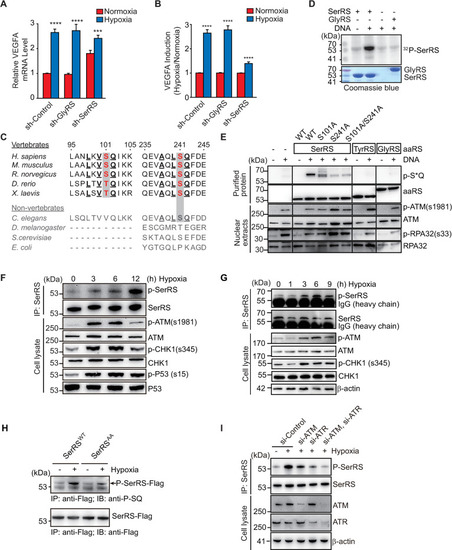|
SerRS is involved in the hypoxia response to induce VEGFA expression through phosphorylation by ATM and ATR kinases at S101 and S241 residues.(A, B) qRT-PCR analysis of VEGFA expression in HEK293 cells transfected with sh-SerRS, sh-GlyRS, or nonspecific sh-Control under hypoxia or normoxia conditions. VEGFA levels (A) and relative induction of VEGFA under hypoxia (B) were plotted as means ± SEM (n = 4, biological replicates, Student t test, **p < 0.01, ****p < 0.0001). (C) Sequence alignment of SerRS proteins from vertebrates and non-vertebrates flanking serine 101 and serine 241 (highlighted in red) sites numbered according to the human sequence. The conserved ATM/ATR substrate motif residues are underlined. (D) 32P-labeling to confirm phosphorylation of SerRS, but not GlyRS, in vitro using recombinant tRNA synthetases. Double-stranded DNA oligonucleotides are used to mimic DNA damage to activate ATM/ATR from the nuclear extract of HEK293 cells. (E) Western blot analysis to confirm recombinant SerRS, but not GlyRS and TyrRS, is phosphorylated by ATM/ATR by using a specific antibody against phosphor-ATM/ATR substrate (p-S*Q). The purified His6-tagged aaRS proteins are recognized by anti-His6-tag antibody. Activation of ATM and ATR was confirmed by autophosphorylation of ATM (at S1981) and phosphorylation of RPA32 (at S33), respectively. (F, G) IP and western blot analysis to confirm hypoxia-induced SerRS phosphorylation in HEK293 (F) and HUVEC (G) cells. IP was performed with anti-SerRS antibody from mouse and rabbit for HEK293 (F) and HUVEC (G) cells, respectively. Phosphorylated SerRS was detected with the antibody against phosphor-ATM/ATR substrate (p-S*Q) from rabbit. Activation of ATM and ATR was confirmed by autophosphorylation of ATM (at S1981) and phosphorylation of CHK1 (at S345) and P53 (at S15). (H) Hypoxia-induced phosphorylation of SerRS in HEK293 cells is reduced in SerRSAA compared with SerRSWT. (I) Hypoxia-induced phosphorylation of SerRS was decreased when ATM and ATR were knocked down separately or together by siRNAs (si-ATM, si-ATR). At least 2 biological replicates were performed for western blot experiments with consistent results. Representative images were shown. See S1 Data for quantitative data and statistical analysis. See S2 Data for original, uncropped images supporting blots and gel results. aaRS, aminoacyl-tRNA synthetase; ATM, ataxia telangiectasia mutated; ATR, ataxia telangiectasia mutated and RAD3-related; GlyRS, glycyl-tRNA synthetase; HUVEC, human umbilical vein endothelial cell; IP, immunoprecipitation; qRT-PCR, real-time quantitative reverse transcription PCR; SerRS, seryl-tRNA synthetase; SerRSAA, S101A/S241A; SerRSWT, wild-type SerRS; sh-Control, control shRNA; sh-GlyRS, shRNAs targeting GlyRS; sh-SerRS, shRNAs targeting SerRS; siRNA, small interfering RNA; TyrRS, tyrosyl-tRNA synthetase; VEGFA, vascular endothelial growth factor A.
|

